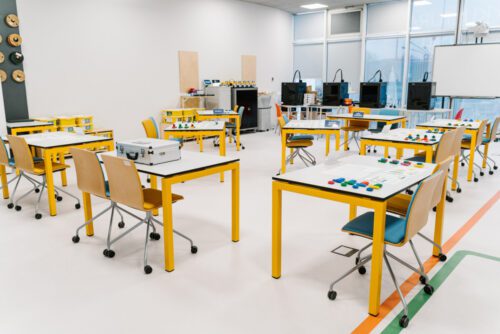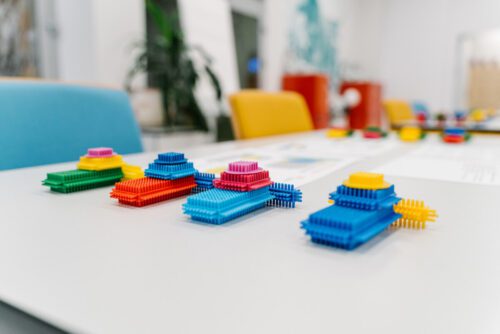
Teamwork Trainings to Strengthen Workplace Bonds
April 24, 2025
Top 5 Process Improvement Techniques for Boosting Efficiency
April 24, 2025The Best Lean Manufacturing Game to Enhance Your Team Skills
Lean manufacturing games teach lean principles through interactive, hands-on activities. This article explores how these games work and their benefits for your team.
Key Takeaways
- The Lean Manufacturing Game offers hands-on experience in identifying waste and improving efficiency, fostering a culture of continuous improvement among team members.
- Engagement in these interactive games enhances the retention of lean concepts and improves collaboration, ultimately translating into better teamwork and improved real-world performance.
- Effective implementation requires careful planning, post-game reflections, and a straightforward follow-up process to integrate lessons learned into daily operations.
What is a Lean Manufacturing Game?

Lean Manufacturing Game is an interactive tool designed to illustrate lean principles, helping participants understand manufacturing processes and the impact of implementing lean strategies. The primary objective of these games is to enhance team skills and productivity by immersing participants in a simulated environment that mirrors actual manufacturing challenges. Participants gain valuable hands-on experience by identifying waste and improving efficiency through real-world production scenarios.
These games emphasize the importance of continuous improvement and operational excellence, fostering a culture where team members are encouraged to contribute to process enhancements. Participants can gain insights into strategic decision-making by learning how to apply lean concepts effectively in their organizational contexts. The experiential learning process helps reinforce key lean principles, making it easier for participants to internalize and use them in real-world settings.
The lean manufacturing game covers a range of lean methodologies, including Lean Six Sigma, the Toyota Production System, and more. Teams learn to collaborate more effectively, streamline processes, and deliver better value to customers through these games. Whether it’s a lean simulation game, a lean Lego game, or other interactive activities, these games are designed to make learning about lean manufacturing both engaging and impactful.
Why Your Team Needs Lean Manufacturing Game
Participating in a lean game can significantly enhance your team’s productivity by aligning team members toward common goals. This game fosters a culture of continuous improvement, encouraging team members to seek ways to enhance their processes and minimize waste continually. The hands-on nature of these games provides a safe environment for teams to practice problem-solving skills without the fear of real-world consequences.
Engaging in interactive learning through a lean game can lead to higher retention rates of lean concepts. When actively involved in the learning process, team members are more likely to remember and apply what they’ve learned, which can result in more effective implementation of lean principles within your organization.
Moreover, playing lean games fosters collaboration and communication among team members. Team members develop stronger working relationships and learn to communicate more effectively by collaborating to solve simulated production challenges. This improved teamwork can translate into better performance and higher efficiency in real-world scenarios.
Key Elements of an Effective Lean Manufacturing Game
For a lean manufacturing game to be effective, it must incorporate key lean concepts such as Takt Time, SMED, Kanban, and Just-in-Time. These concepts are integral to understanding and implementing lean manufacturing principles. The GET LEAN simulation, for example, focuses on teaching employees to deliver value to customers and enhance satisfaction.
An essential aspect of these games is allowing a participant to make mistakes. Facilitators must create an environment where mistakes are seen as learning opportunities rather than failures. This variation helps participants gain real-world experience and understand the consequences of their decisions without the risk of actual production disruptions.
The post-game analysis is another critical element. Teams should compare the performance of different stations, teams, and rounds to identify areas for continuous improvement. Reviewing data in various formats, such as bar graphs and PDFs, can help assess performance effectively and highlight areas for enhancement. Value Stream Mapping can also be valuable in identifying waste and improving efficiency while implementing lean games and standard work.
Collaborative methods, such as Lean Six Sigma, can also be introduced to reduce waste and achieve operational excellence. Instructors can customize the game by adjusting layouts, products, and customer demand to meet the team’s specific needs. Scenarios can be adjusted based on the number of players or by allowing the computer to fulfill unfulfilled roles, enhancing interactivity. Setting multiple rounds with incremental improvements can encourage ongoing learning and adaptation.
Types of Lean Manufacturing Games

Lean manufacturing games come in various forms, offering unique benefits and learning experiences. These include Digital Lean Simulation Games, Hands-On Lean Games, and Hybrid Lean Training Sessions.
Each type of game offers a distinct approach to learning and applying lean principles, catering to the diverse needs and preferences of teams.
Digital Lean Simulation Games
Digital lean simulation games are software development-based tools replicating real-world production scenarios, enhancing learner engagement through virtual environments. These games allow players to experience production challenges, mimicking real-life operational hurdles. These games, by immersing participants in a simulated environment, can improve retention skills by up to 40%.
Features such as data analysis and feedback mechanisms further enhance the learning outcomes of digital lean simulation games. Players can track their performance, identify areas for improvement, and apply lean principles more effectively. These games also provide an opportunity to experiment with different strategies and see the immediate impact of their decisions without the risk of real-world consequences.
Digital lean simulation games are an excellent way to introduce team members to lean concepts and practices. They provide a safe and controlled environment for learning and experimentation, making them an invaluable tool for organizations seeking to implement lean manufacturing principles.
Hands-On Lean Games
Hands-on lean games involve interactive physical activities where participants engage in tasks that reflect lean methodologies. One popular example is the Lean Lego Game, where participants build structures under certain constraints to learn about efficiency. The primary goal of the lean game is to maximize productivity.
In the Lean Lego Game, the second hands-on exercise represents a pull system, demonstrating an efficient task flow that fills the group participants’ needs. The third hands-on exercise represents a work cell, emphasizing teamwork and efficiency. Participants decided that their team depended on them to achieve optimal performance. The debrief focuses on reviewing what went well, identifying areas for improvement, and following the instructions provided, using one set of guidelines and LEGO bricks. Additionally, the concept of one-piece flow is highlighted to enhance efficiency in the workshop.
Another hands-on activity is the Ball Game, which focuses on eliminating waste by improving the efficiency of task execution through teamwork. Teams can explore different methodologies for waste reduction by incorporating various lean games, such as the Lean Lego Game and the Ball Game. The best way to operate in rounds during hands-on games encourages continuous engagement and learning while addressing the issue of resource wastage.
Hands-on lean games provide interactive experiences that enhance understanding of lean principles and improve team dynamics. They are an excellent way to engage team members in lean training sessions, making learning fun and impactful.
Hybrid Lean Training Sessions
Hybrid lean training sessions combine elements of both digital and physical games to provide a more comprehensive learning experience. By integrating the benefits of virtual simulations and hands-on activities, these sessions offer a balanced approach to learning lean principles.
These sessions can be tailored to the team’s specific needs, providing a more personalized and practical training experience for each individual. Participants can benefit from the interactive nature of digital games, which combines with hands-on exercises to reinforce the concepts learned.
This hybrid approach ensures a well-rounded understanding of lean manufacturing principles.
Implementing Lean Manufacturing Games in Your Organization

Implementing lean manufacturing games in your organization requires careful planning and execution. Post-game reflections are crucial, as they enable players to connect their experiences to their work environments. Teams should discuss what they learned from the game and how it applies to daily tasks. This reflection process ensures that the lessons learned are not forgotten and can be effectively implemented in the workplace.
Effective learning occurs when lean principles are taught to participants after they have experienced the game. This approach helps reinforce the concepts and makes them more relatable to the participants. Organizations should also ensure a follow-up process to track the specific improvements suggested by the game insights. This follow-up is crucial to avoid creating false expectations and to ensure that the learned concepts are effectively integrated into the organization’s processes.
By implementing lean manufacturing games, organizations can enhance their team’s skills, improve productivity, and foster a culture of continuous improvement. These games provide a valuable tool for teaching lean principles and driving operational excellence.
Case Study: Successful Implementation of Lean Manufacturing Games
Consider the case of a company that reported a 63% increase in job performance after implementing game-based learning training. This significant improvement highlights the impactful results achieved through lean manufacturing games. For instance, the GET LEAN simulation promotes transformation by fostering change through cooperation and well-planned strategies.
The implementation of lean manufacturing games enhanced productivity and teamwork within the organization. By engaging team members in interactive learning experiences, the company fostered better collaboration and communication, leading to improved overall performance and customer satisfaction.
This case study illustrates the potential benefits of incorporating lean manufacturing games into organizational training programs. By leveraging these interactive tools, companies can achieve substantial improvements in job performance and operational efficiency.
Common Challenges and Solutions
Despite the numerous benefits of lean manufacturing, organizations often face common challenges. One major challenge is the failure to properly measure and visualize key performance indicators during the game, which can hinder participants’ ability to assess their progress. Measurements and visual management are crucial for tracking progress and guiding discussions during the game.
Regular performance reviews and adjustments are critical in the lean implementation process to ensure ongoing improvement. Facilitators should use open-ended questions to encourage participants to think more deeply and engage in analysis. This approach enables participants to learn from their mistakes rather than having lean concepts pushed onto them.
Another challenge is the potential for games to create false expectations about lean processes if not properly facilitated. Teams often encounter a lack of clear objectives, which can lead to confusion and ineffective outcomes during play. Without a defined transformation strategy in place after the game, organizations may struggle to integrate the learned concepts into their processes. Resistance from team members can also impede the implementation of new methodologies in lean processes.
To overcome these challenges, it’s essential to have well-defined objectives, effective facilitation, and a straightforward follow-up process. Addressing these challenges ensures the successful implementation of lean manufacturing games and achieving the desired outcomes for organizations.
How can organizations effectively implement lean manufacturing games?
To implement lean manufacturing games effectively, organizations should emphasize post-game reflections, teach lean principles thoroughly, and establish a follow-up process to monitor improvements. This approach ensures sustained learning and continuous enhancement of lean practices.
Summary
In summary, lean manufacturing games are powerful tools for enhancing team skills and productivity. By providing hands-on experience with lean principles, these games foster a culture of continuous improvement and operational excellence. Whether it’s through digital simulations, hands-on activities, or hybrid training sessions, lean games offer a valuable learning experience for teams.
Implementing lean manufacturing games in your organization can lead to significant improvements in teamwork, communication, and overall job performance. By addressing common challenges and ensuring effective facilitation, organizations can maximize the benefits of these interactive tools. Embrace the power of lean manufacturing games and transform your team’s performance today!
Suppose you’ve realized that a simulation game can be a powerful training tool. In that case, I invite you to watch a short video showcasing our simulation game – the result of over 6 years of development and improvement.
Frequently Asked Questions
What are lean manufacturing games?
Lean manufacturing games are interactive activities designed to demonstrate lean principles, enabling participants to effectively grasp manufacturing processes and the effects of lean strategies. These games foster practical understanding and engagement with lean methodologies.
Why are lean games important for teams?
Lean games are crucial for teams as they boost productivity, promote continuous improvement, and strengthen collaboration and communication. Engaging in these activities helps create a more cohesive and efficient work environment.
What are the key elements of an effective lean manufacturing game?
An effective lean manufacturing game must incorporate key concepts such as Takt Time, SMED, Kanban, and Just-in-Time while also allowing participants the opportunity to make mistakes and facilitating post-game analysis to enhance learning. These elements are crucial for fostering a deep understanding of lean principles.
What types of lean manufacturing games are there?
Lean manufacturing games come in three main types: digital simulations, hands-on activities, and hybrid training sessions that combine both approaches. Each offers unique advantages for learning and applying lean principles effectively.
